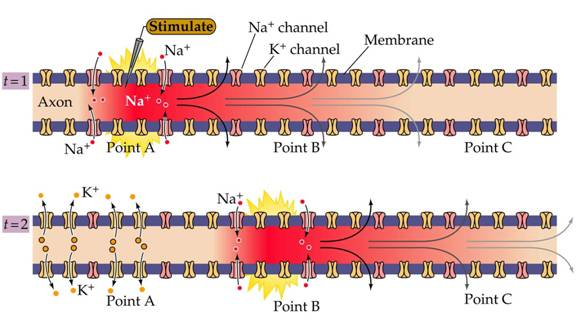Action potential conduction
According to physiology, an action potential is a short-lasting event in which the electrical membrane potential of a cell quickly rises and falls, subsequent to a consistent trajectory. The Action potentials arises in several kinds of animal cells, known as the excitable cells, that include muscle cells, neurons, and endocrine cells, and also in some plant cells. In neurons, they play a vital role in cell-to-cell communication. In other kinds of cells, their main function is to activate intracellular processes. In muscle cells, for illustration, the action potential is the first step in chain of events leading to contraction. In the beta cells of pancreas, they provoke release of insulin. The Action potentials in neurons are also termed as "spikes", or "nerve impulses", and the temporal series of action potentials produced by a neuron is termed as "spike train". The neuron which emits an action potential is frequently said to "fire".

Figure:Action potential conduction
The Action potentials are generated by special kinds of voltage-gated ion channels embedded in a cell's plasma membrane. Such channels are shut whenever the membrane potential is near the resting potential of the cell, but they rapidly start to open when the membrane potential increases to a accurately defined threshold value. Whenever the channels open, they permit an inward flow of sodium ions that changes the electrochemical gradient that in turn generates a further rise in the membrane potential. This causes many channels to open, producing a larger electric current, and so forth. The procedure proceeds explosively until all of the available ion channels are open, resultant in a large upswing in the membrane potential.
The fast influx of sodium ions causes the polarity of the plasma membrane to reverse, and the ion channels then quickly inactivate. Since the sodium channels close, the sodium ions cannot enter the neuron, and they are dynamically transported out of the plasma membrane. The Potassium channels are then activated, and there is a current outward of the potassium ions, returning electrochemical gradient to the resting state. Afterward an action potential has occurred; there is a transient negative shift, known as the afterhyperpolarization or refractory period, due to the additional potassium currents. This is the mechanism which checks an action potential from traveling back the way it came.